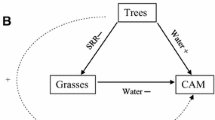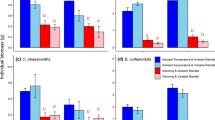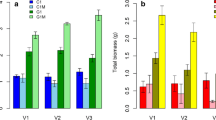Abstract
Past studies have largely focused on hydraulic redistribution (HR) in trees, shrubs, and grasses, and recognized its role in interspecies interactions. HR in plants that conduct crassulacean acid metabolism (CAM), however, remains poorly investigated, as does the effect of HR on transpiration in different vegetation associations (i.e., tree–grass, CAM–grass, and tree–CAM associations). We have developed a mechanistic model to investigate the net direction and magnitude of HR at the patch scale for tree–grass, CAM–grass, and tree–CAM associations at the growing season to yearly timescale. The modeling results show that deep-rooted CAM plants in CAM–grass associations could perform hydraulic lift at a higher rate than trees in tree–grass associations in a relatively wet environment, as explained by a significant increase in grass transpiration rate in the shallow soil layer, balancing a lower transpiration rate by CAM plants. By comparison, trees in tree–CAM associations may perform hydraulic descent at a higher rate than those in tree–grass associations in a dry environment. Model simulations also show that hydraulic lift increases the transpiration of shallow-rooted plants, while hydraulic descent increases that of deep-rooted plants. CAM plants transpire during the night and thus perform HR during the day. Based on these model simulations, we suggest that the ability of CAM plants to perform HR at a higher rate may have different effects on the surrounding plant community than those of plants with C3 or C4 photosynthetic pathways (i.e., diurnal transpiration).






Similar content being viewed by others
References
Anderson EF (2001) The cactus family. Timber Press, Portland
Bacilio M, Vazquez P, Bashan Y (2011) Water versus spacing: a possible growth preference among young individuals of the giant cardon cactus of the Baja California Peninsula. Environ Exp Bot 70:29–36
Baker I, Prihodko L, Denning A, Goulden M, Miller S, Da Rocha H (2008) Seasonal drought stress in the Amazon: reconciling models and observations. J Geophys Res 113:G00B01
Bartlett M, Vico G, Porporato A (2014) Coupled carbon and water fluxes in CAM photosynthesis: modeling quantification of water use efficiency and productivity. Plant Soil 383:111–138
Bhattachan A, Tatlhego M, Dintwe K, O’Donnell F, Caylor KK, Okin GS, Perrot DO, Ringrose S, D’Odorico P (2012) Evaluating ecohydrological theories of woody root distribution in the Kalahari. PLoS One 7:e33996
Borland AM, Griffiths H, Hartwell J, Smith JAC (2009) Exploiting the potential of plants with crassulacean acid metabolism for bioenergy production on marginal lands. J Exp Bot 60:2879–2896
Borland AM, Barrera Zambrano VA, Ceusters J, Shorrock K (2011) The photosynthetic plasticity of crassulacean acid metabolism: an evolutionary innovation for sustainable productivity in a changing world. N Phytol 191:619–633
Brooks JR, Meinzer FC, Warren JM, Domec JC, Coulombe R (2006) Hydraulic redistribution in a Douglas-fir forest: lessons from system manipulations. Plant Cell Environ 29:138–150
Brutsaert W (1982) Evaporation into the atmosphere: theory, history and applications. D. Reidel Publishing Company, Boston
Burgess SS, Adams MA, Turner NC, White DA, Ong CK (2001) Tree roots: conduits for deep recharge of soil water. Oecologia 126:158–165
Caldwell MM, Dawson TE, Richards JH (1998) Hydraulic lift: consequences of water efflux from the roots of plants. Oecologia 113:151–161
Cares RA, Muñoz PA, Medel R, Botto-Mahan C (2013) Factors affecting cactus recruitment in semiarid Chile: a role for nurse effects? Flora 208:330–335
Castillo JP, Valiente-Banuet A (2010) Species-specificity of nurse plants for the establishment, survivorship, and growth of a columnar cactus. Am J Bot 97:1289–1295
Caylor KK, Shugart HH, Rodriguez-Iturbe I (2005) Tree canopy effects on simulated water stress in southern African savannas. Ecosystems 8:17–32
Clapp RB, Hornberger GM (1978) Empirical equations for some soil hydraulic properties. Water Resour Res 14:601–604
Dawson TE (1993) Hydraulic lift and water use by plants: implications for water balance, performance and plant-plant interactions. Oecologia 95:565–574
De La Barrera E, Smith WK (eds) (2009) Perspectives in biophysical plant ecophysiology: a tribute to Park S. Nobel. Mexico City, FD, Universidad Nacional Autónoma de México (UNAM)
Domec J-C, Warren J, Meinzer F, Brooks J, Coulombe R (2004) Native root xylem embolism and stomatal closure in stands of Douglas-fir and ponderosa pine: mitigation by hydraulic redistribution. Oecologia 141:7–16
Egerton-Warburton LM, Querejeta JI, Allen MF (2007) Common mycorrhizal networks provide a potential pathway for the transfer of hydraulically lifted water between plants. J Exp Bot 58:1473–1483
Espeleta J, West J, Donovan L (2004) Species-specific patterns of hydraulic lift in co-occurring adult trees and grasses in a sandhill community. Oecologia 138:341–349
Flexas J, Ribas-Carbó M, Diaz-Espejo A, Galmésl J, Medrano H (2008) Mesophyll conductance to CO2: current knowledge and future prospects. Plant Cell Environ 31:602–621
Guralnick LJ, Ting IP (1987) Physiological changes in Portulacaria afra (L.) Jacq. during a summer drought and rewatering. Plant Physiol 85:481–486
Herzog B, Hoffmann S, Hartung W, Lüttge U (1999) Comparison of photosynthetic responses of the sympatric tropical C3 species Clusia multiflora H.B.K. and the C3-CAM intermediate species Clusia minor L. to irradiance and drought stress in a phytotron. Plant Biol 1:460–470
Horton J, Hart SC (1998) Hydraulic lift: a potentially important ecosystem process. Trends Ecol Evol 13:232–235
Hultine KR, Scott R, Cable W, Goodrich D, Williams D (2004) Hydraulic redistribution by a dominant, warm-desert phreatophyte: seasonal patterns and response to precipitation pulses. Funct Ecol 18:530–538
Jones HG (1992) Plants and microclimate: a quantitative approach to environmental plant physiology. Cambridge University Press, Cambridge
Laio F, Porporato A, Ridolfi L, Rodriguez-Iturbe I (2001) Plants in water-controlled ecosystems: active role in hydrologic processes and response to water stress: II. Probabilistic soil moisture dynamics. Adv Water Resour 24:707–723
Larcher W (2003) Physiological plant ecology: ecophysiology and stress physiology of functional groups. Springer, Berlin, Heidelberg
Lee J-E, Oliveira RS, Dawson TE, Fung I (2005) Root functioning modifies seasonal climate. Proc Natl Acad Sci USA 102:17576–17581
Lhomme J-P, Rocheteau A, Ourcival J, Rambal S (2001) Non-steady-state modelling of water transfer in a Mediterranean evergreen canopy. Agric For Meteorol 108:67–83
Ludwig F, Dawson TE, de Kroon H, Berendse F, Prins HH (2003) Hydraulic lift in Acacia tortilis trees on an East African savanna. Oecologia 134:293–300
Ludwig F, Dawson T, Prins H, Berendse F, Kroon H (2004) Below-ground competition between trees and grasses may overwhelm the facilitative effects of hydraulic lift. Ecol Lett 7:623–631
Lüttge U (2004) Ecophysiology of crassulacean acid metabolism (CAM). Ann Bot 93:629–652
Manzoni S, Vico G, Porporato A, Katul G (2013) Biological constraints on water transport in the soil–plant–atmosphere system. Adv Water Resour 51:292–304
McCulley R, Jobbagy E, Pockman W, Jackson R (2004) Nutrient uptake as a contributing explanation for deep rooting in arid and semi-arid ecosystems. Oecologia 141:620–628
Miszalski Z, Kornas A, Rozpądek P, Fischer-Schliebs E, Lüttge U (2013) Independent fluctuations of malate and citrate in the CAM species Clusia hilariana Schltdl. under low light and high light in relation to photoprotection. J Plant Physiol 170:453–458
Mooney HA, Gulmon S, Rundel PW, Ehleringer J (1980) Further observations on the water relations of Prosopis tamarugo of the northern Atacama desert. Oecologia 44:177–180
Nelson EA, Sage RF (2008) Functional constraints of CAM leaf anatomy: tight cell packing is associated with increased CAM function across a gradient of CAM expression. J Exp Bot 59:1841–1850
Neumann RB, Cardon ZG (2012) The magnitude of hydraulic redistribution by plant roots: a review and synthesis of empirical and modeling studies. N Phytol 194:337–352
Nippert JB, Wieme RA, Ocheltree TW, Craine JM (2012) Root characteristics of C4 grasses limit reliance on deep soil water in tallgrass prairie. Plant Soil 355:385–394
Nobel PS (2003) Environmental biology of agaves and cacti. Cambridge University Press, Cambridge
Nobel PS, Sanderson J (1984) Rectifier-like activities of roots of two desert succulents. J Exp Bot 35:727–737
North GB, Nobel PS (1995) Hydraulic conductivity of concentric root tissues of Agave deserti Engelm. under wet and drying conditions. N Phytol 130:47–57
Ogburn R, Edwards EJ (2010) The ecological water-use strategies of succulent plants. Adv Bot Res 55:179–225
Porporato A, Laio F, Ridolfi L, Caylor KK, Rodriguez-Iturbe I (2003) Soil moisture and plant stress dynamics along the Kalahari precipitation gradient. J Geophys Res 108(D3):4127
Prieto I, Armas C, Pugnaire FI (2012) Water release through plant roots: new insights into its consequences at the plant and ecosystem level. N Phytol 193:830–841
Quijano JC, Kumar P, Drewry DT, Goldstein A, Misson L (2012) Competitive and mutualistic dependencies in multispecies vegetation dynamics enabled by hydraulic redistribution. Water Resour Res 48:W05518
Rayder L, Ting IP (1981) Carbon metabolism in two species of Pereskia (Cactaceae). Plant Physiol 68:139–142
Richards JH, Caldwell MM (1987) Hydraulic lift: substantial nocturnal water transport between soil layers by Artemisia tridentata roots. Oecologia 73:486–489
Ripley BS, Abraham T, Klak C, Cramer MD (2013) How succulent leaves of Aizoaceae avoid mesophyll conductance limitations of photosynthesis and survive drought. J Exp Bot 64:5485–5496
Rocha FS, Duarte Waechter JL, Duarte LDS (2015) Positive association between Bromelia balansae (Bromeliaceae) and tree seedlings on rocky outcrops of Atlantic forest. J Trop Ecol 31:195–198
Rodriguez-Iturbe I, D’odorico P, Porporato A, Ridolfi L (1999) On the spatial and temporal links between vegetation, climate, and soil moisture. Water Resour Res 35:3709–3722
Ryel R, Caldwell M, Yoder C, Or D, Leffler A (2002) Hydraulic redistribution in a stand of Artemisia tridentata: evaluation of benefits to transpiration assessed with a simulation model. Oecologia 130:173–184
Ryel RJ, Leffler A, Peek M, Ivans C, Caldwell M (2004) Water conservation in Artemisia tridentata through redistribution of precipitation. Oecologia 141:335–345
Scott RL, Cable WL, Hultine KR (2008) The ecohydrologic significance of hydraulic redistribution in a semiarid savanna. Water Resour Res 44:W02440
Szarek SR, Troughton JH (1976) Carbon isotope ratios in crassulacean acid metabolism plants seasonal patterns from plants in natural stands. Plant Physiol 58:367–370
Ting IP (1981) Effects of abscisic acid on CAM in Portulacaria afra. Photosynth Res 2:39–48
Warren JM, Brooks JR, Meinzer FC, Eberhart JL (2008) Hydraulic redistribution of water from Pinus ponderosa trees to seedlings: evidence for an ectomycorrhizal pathway. N Phytol 178:382–394
Winter K, Garcia M, Holtum JA (2009) Canopy CO2 exchange of two neotropical tree species exhibiting constitutive and facultative CAM photosynthesis, Clusia rosea and Clusia cylindrica. J Exp Bot 60:3167–3177
Withgott J (2000) Botanical nursing: from deserts to shorelines, nurse effects are receiving renewed attention. Bioscience 50:479–484
Yoder C, Nowak R (1999) Hydraulic lift among native plant species in the Mojave Desert. Plant Soil 215:93–102
Yu K, D’Odorico P (2014a) Climate, vegetation, and soil controls on hydraulic redistribution in shallow tree roots. Adv Water Resour 66:70–80
Yu K, D’Odorico P (2014b) An ecohydrological framework for grass displacement by woody plants in savannas. J Geophys Res 119:2013JG002577
Yu KL, D’Odorico P (2015a) Hydraulic lift as a determinant of tree–grass coexistence on savannas. N Phytol 207(4):1038–1051. doi:10.1111/nph.13431
Yu KL, D’Odorico P (2015b) Direct and indirect facilitation of plants with Crassulacean Acid Metabolism (CAM). Ecosystem 18:985–999. doi:10.1007/s10021-015-9877-6
Zou CB, Barnes PW, Archer S, McMurtry CR (2005) Soil moisture redistribution as a mechanism of facilitation in savanna tree–shrub clusters. Oecologia 145:32–40
Zou CB, Royer PD, Breshears DD (2010) Density-dependent shading patterns by Sonoran saguaros. J Arid Environ 74:156–158
Acknowledgments
This study is supported by China Scholarship Council. The clarity and strength of the paper were improved by comments of the handing editor (Todd Dawson) and anonymous reviewers to whom we are grateful. We also would like to thank Paolo D’odorico for his edits of the paper and Mark Bartlett for his help in CAM modeling.
Author contribution statement
KLY developed the idea, designed and developed the model, and wrote the manuscript. AF originally conceived the idea and wrote the manuscript.
Author information
Authors and Affiliations
Corresponding author
Additional information
Communicated by Todd E. Dawson.
Electronic supplementary material
Below is the link to the electronic supplementary material.
Rights and permissions
About this article
Cite this article
Yu, K., Foster, A. Modeled hydraulic redistribution in tree–grass, CAM–grass, and tree–CAM associations: the implications of crassulacean acid metabolism (CAM). Oecologia 180, 1113–1125 (2016). https://doi.org/10.1007/s00442-015-3518-9
Received:
Accepted:
Published:
Issue Date:
DOI: https://doi.org/10.1007/s00442-015-3518-9




